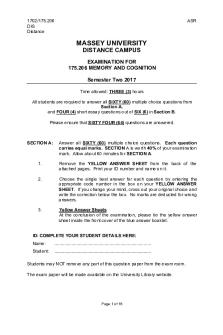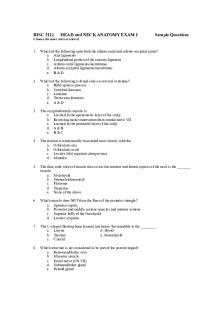Exam 1- questions PDF

| Title | Exam 1- questions |
|---|---|
| Course | International Finance |
| Institution | University of North Florida |
| Pages | 6 |
| File Size | 205.4 KB |
| File Type | |
| Total Downloads | 11 |
| Total Views | 141 |
Summary
Exam 1 preparation questions...
Description
EXAM Q1- Exchange rates in the supply and demand.Explain write the equation, identify and emphasize factors and what they are. One of those in graphical and verbal representation, which effects have the variable in the exchange rate. Supply, demand, equilibrium… Exchange rate: is the value of one domestic currency in terms of a foreign currency. Demand for a currencyà increases when the value of the currency decreases, leading to a downward sloping demand schedule Supply of a currency for saleà increases when the value of the currency increases, leading to an upward sloping supply schedule. Equilibrium: when quantity of the currency demanded and supplied are equal. The equilibrium exchange rate will change over time as supply and demand change
FACTORS AFFECTING THE EXCHANGE RATES: Relative Inflation Rates: Increase in U.S. inflation leads to increase in U.S. demand for foreign goods, an increase in U.S. demand for foreign currency, and an increase in the exchange rate for the foreign currency. Relative Interest Rates: Increase in U.S. rates leads to increase in demand for U.S. deposits and a decrease in demand for foreign deposits, leading to an increase in demand for dollars and an increased exchange rate for the dollar. Relative Income Levels: Increase in U.S. income leads to increased in U.S. demand for foreign goods and increased demand for foreign currency relative to the dollar and an increase in the exchange rate for the foreign currency. Government Controls via:
-
Imposing foreign exchange barriers Imposing foreign trade barriers Intervening in foreign exchange markets Affecting macro variables such as inflation, interest rates, and income levels.
EXAM Q2- Balance Of Payments. Types of 3 accounts (name and subdivisions with details) One of the impacts of Macroeconomic events in accounts is exchange rates. Explain effect it has on current account works and reason why it is not implemented. Balance of payments (BOP)à Summary of transactions (cash flows/funds) between domestic and foreign residents for a specific country over a specified period of time. COMPONENTS OF THE BALANCE OF PAYMENTS STATEMENT: 1. Current Account: summary of flow of funds due to purchases of goods or services or the provision of income on financial assets. Balance of trade: X-I: (negative is deficit and positive is surplus) Factor payment: income generated from dividends, interest payments Transfer payment: gifts, aids, and grant
-
2. Capital Account: summary of flow of funds resulting from the sale of assets between one specified country and all other countries over a specified period of time. -
Includes patents and trademarks
3. Financial Account: refers to special types of investment, including DFI and portfolio investment. -
Direct foreign investmentà Investments in fixed assets in foreign countries
-
Portfolio investmentà Transactions involving LONG TERM financial assets (such as stocks and bonds) between countries that do not affect the transfer of control.
-
Other capital investmentàTransactions involving SHORT-TERM financial assets (such as money market securities) between countries.
MACROECONOMIC EVENTS that stimulate THE CURRENT ACCOUNT -
-
EXCHANGE RATE CHANGES: EURUSD 1.1716 à 1.1725 (Eur has appreciated, and dollar depreciated) “relative inflation” COST OF LABOUR: less labour, less costs, less prices, more exports However, does NOT APPLY to USA as we don’t have anything to export. DON’T USE IT IN THE EXAM
-
NATIONAL INCOME: relative to expenses CREDIT CONDITIONS: import ease to loan or borrow money INFLATION: GOVERNMENT POLICIES: tariffs, quotas…stimulate or prevent exports/imports
EXAM
Exchange Rates (IMP): current account decreases if currency appreciates relative to other currencies. How exchange rates may correct a balance of trade deficit: When a home currency is exchanged for a foreign currency to buy foreign goods, then the home currency faces downward pressure, leading to increased foreign demand for the country’s products. To stimulate the CA: Depreciation of domestic currency: increase demand for productsàhigher exportsà increased volume of fundsà CA increases *Exchange rates will not automatically correct any international trade balances when other forces are at work. -
There are limitations the $ has high demand/ safe heaven To manipulate currency some reserves are needed, US does not have US is an import country
Limitations of a Weak Home Currency Solution 1. Competition: foreign companies may lower their prices to remain competitive. 2. Impact of other currencies: a country that has balance of trade deficit with many countries is not likely to solve all deficits simultaneously. 3. Prearranged international trade transactions: international transactions cannot be adjusted immediately. The lag is estimated to be 18 months or longer, leading to a J-curve effect.
Q3- 15. how Multinational corporations can participate in international markets. No investors or stock markets or. 4 or 5 risk From least risk to riskiest 1. INTERNATIONAL TRADE: Penetrate markets by exporting Obtain supplies at a low cost by importing Minimal risk- the firm does not place any of its capital at risk 2. LICENSING Provide a company’s technology (IP) in exchange for fees or specified benefits - Lower cost if not stablishing production plants or transporting goods to foreign countries 3. FRANCHISING Obligates firm to provide a specialized sales or service strategy, support assistance and maybe an initial investment in the franchise in exchange for periodic fees.
EXAM -
Franchising by an MNC often requires a direct investment in foreign operations. “FDI” franchising allows firms to penetrate foreign markets without a major investment in foreign countries.
4. JOINT VENTURES A venture that is jointly owned and operated by 2 or more firms, Enter a foreign market by joint venturing with a domestic firm, Cooperative advantages in a cooperative project. - Risky but reduced because local firm already stablished and knows the market 5. ACQUISITIONS OF EXISTING OPERATIONS (M&A) Acquisition of firms in foreign countries allows firms to have full control over their foreign business and to quickly obtain a large portion of the foreign market share. - Very large investment. Riskiest - Liquidation difficult is the foreign performs poorly - Also, partial international acquisitions which are less risky, but not full control 6. ESTABLISHMENT OF NEW FOREIGN SUBSIDIARIES ‘Merger’ Penetrate foreign markets by establishing new operations in foreign countries to produce and sell their products. - large investment. - Preferred to foreign acquisitions because the operations can be tailored exactly to the firm’s needs. - A smaller investment may be required than would be needed to purchase existing operations. - However, the firm will not reap any rewards from the investment until the subsidiary is built and a customer base established- (Takes long to earn capital) - Culture risk
Q3- PRACTICE. Crossratesà 9 bin and ask spreads. Calculate 3. Multiplication and división-(round up to the fourth decimal) Q4- AGENCY COST. What is it- name players, why problem to MNC, to America….What can you do to minimize them Agency problemsà The conflict of goals between managers (agent) and shareholders (principal) Agency costsà Cost of ensuring that managers maximize shareholder wealth Why costs are higher for MNCs than for domestic firms:
EXAM
-
Distant subsidiaries in foreign countries is more difficult Different cultures of MNC ‘s managers may differ goals. The big size of the larger MNCs can also create significant agency problems. Non-US managers downplay short-term effect of decisionsà maximize foreign subsidiary values or pursue other goals
MINIMIZE COSTS? 1. Parent Control of Agency Problems à The parent corporation of an MNC may be able to prevent most agency problems with proper governance. The parent should clearly communicate the goals for each subsidiary to ensure that all of them focus on maximizing the value of the MNC and not of their respective subsidiaries 2. Corporate Control of Agency Problemsà the goals of the entire management of the MNC are not focused on maximizing shareholder wealth. 3. A centralized management styleà can reduce agency costs because it allows managers of the parent to control foreign subsidiaries and thus reduces the power of subsidiary managers.
Q5- CROSSRATE Q6-Multinational corporations- what can invertors do to obtain a share in multinational corporation International investors MUTUAL FUNDS: -
Actively managed Expensive due to many fees associated with maintenance Open-ended Redeemable at Net Asset Value available at end of trading day. Sensitive to re-balancing (certain stocks may be replaced)
Exchange Traded Funds (ETF) -
Passively managed Closed-ended; trading in open markets similar to stocks More flexibility in transactions Less expensive
EXAM American Depositary Receipts (ADR) -
Securitization Pool of company’s deposits are subsequently divided in marketable securities Allows domestic investors to invest in fractions of international firms Sensitive to currency exchange rates
Cross-Listing -
Companies have a representation in two or more stocks markets Very expensive for participating firms (you pay firms in each market) Even though international stock prices may differ, no real opportunity for arbitrage...
Similar Free PDFs

Exam 1 - Past Exam Questions
- 8 Pages

Patho Exam 1 questions
- 6 Pages

Exam 1 2017, questions
- 10 Pages

EXAM 1 Review - Questions
- 30 Pages

CASE 1 EXAM Questions
- 10 Pages

Exam 1 Practice Questions
- 3 Pages

Year 1 exam questions
- 8 Pages

Exam 1 December, questions
- 16 Pages

Exam 1 questions
- 12 Pages

Exam 1 - Practice Questions
- 5 Pages

Exam 1 review questions
- 28 Pages

Exam 1 Sample Questions
- 2 Pages

Exam 1 sample questions
- 13 Pages

Exam 1 review questions
- 6 Pages

Exam 1 2015, questions
- 9 Pages
Popular Institutions
- Tinajero National High School - Annex
- Politeknik Caltex Riau
- Yokohama City University
- SGT University
- University of Al-Qadisiyah
- Divine Word College of Vigan
- Techniek College Rotterdam
- Universidade de Santiago
- Universiti Teknologi MARA Cawangan Johor Kampus Pasir Gudang
- Poltekkes Kemenkes Yogyakarta
- Baguio City National High School
- Colegio san marcos
- preparatoria uno
- Centro de Bachillerato Tecnológico Industrial y de Servicios No. 107
- Dalian Maritime University
- Quang Trung Secondary School
- Colegio Tecnológico en Informática
- Corporación Regional de Educación Superior
- Grupo CEDVA
- Dar Al Uloom University
- Centro de Estudios Preuniversitarios de la Universidad Nacional de Ingeniería
- 上智大学
- Aakash International School, Nuna Majara
- San Felipe Neri Catholic School
- Kang Chiao International School - New Taipei City
- Misamis Occidental National High School
- Institución Educativa Escuela Normal Juan Ladrilleros
- Kolehiyo ng Pantukan
- Batanes State College
- Instituto Continental
- Sekolah Menengah Kejuruan Kesehatan Kaltara (Tarakan)
- Colegio de La Inmaculada Concepcion - Cebu
